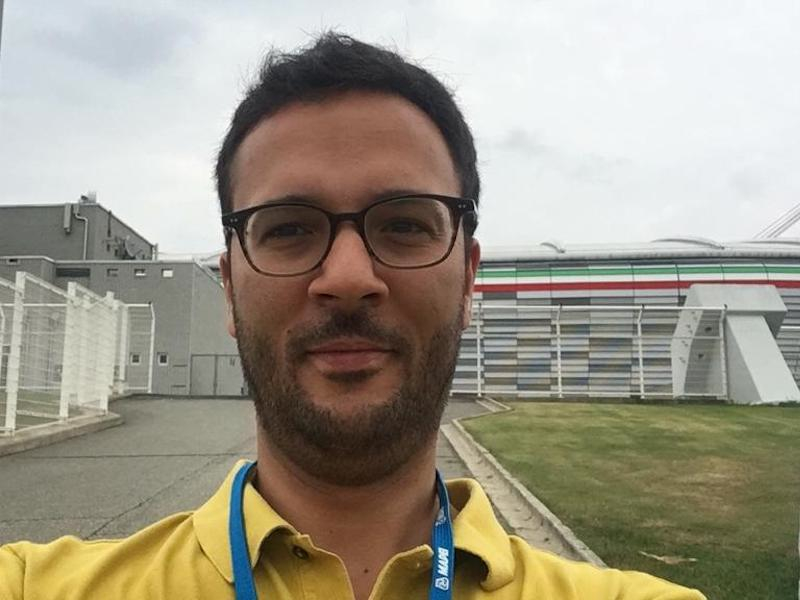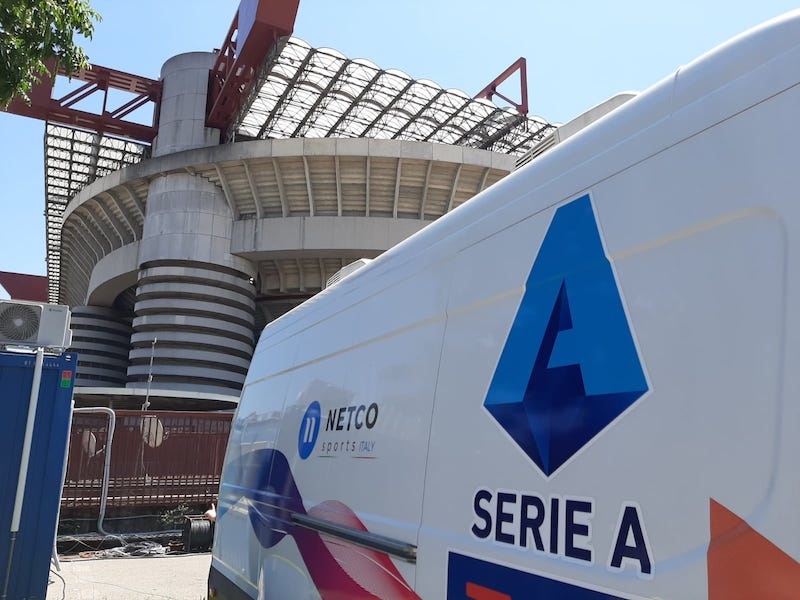Virtualisation of fans breathes life into stadiums for the return of Serie A
Netco Sports helps the unreal become more real behind closed doors in Italy's stadiums
After the COVID-19 emergency of the first months of 2020, the coveted resumption of sports activities has had to deal with a less spectacular television show due to the total lack of fans in the stadiums.
Empty stands and the missing enthusiasm of the fans have removed a lot of ‘colour’ from matches and forced the various football leagues to look at the possibility of putting imaginative graphic alternatives on the field to help bring ‘fans’ into the match.
 During the game home spectators are mainly focused on the action and the player in possession of the ball; unfortunately, however, there are periods such as the pre-game, half-time and post-game in which the TV images are really empty, without appeal, precisely because the large frame captures the desolation of the empty stands in full.
During the game home spectators are mainly focused on the action and the player in possession of the ball; unfortunately, however, there are periods such as the pre-game, half-time and post-game in which the TV images are really empty, without appeal, precisely because the large frame captures the desolation of the empty stands in full.
Given this consideration, one of the four Italian subsidiaries of the international Euro Media Group, Netco Sports, in partnership with Interregional Sports Group (ISG), developed a ‘virtual’ dimension with team colours and sponsor branding.
After some simulations, the Lega Calcio Serie A chose a ‘simplified’ virtualisation to be applied, during the pre- and post-game and in the interval.
100 games in 30 days
Given the physical impossibility of going to the stadiums during the quarantine period to carry out tests, during the proposal and testing phase Netco Sports had to recover static images and broad perspectives from its archive to create renders that could simulate the final output – but in offline mode.
After the static tests it was necessary to explore the potential of the system because it was crucial to understand that even with a camera movement, such as a pan or a zoom, this technology would have always allow the virtual graphics to be viewed in the right perspective. The next step was, therefore, to test these graphic elements within a technology framework that also included tracking.
Netco Sports sales manager Claudio Cavalolotti told SVG Europe, “after some very positive tests, and checking that there was sufficient elasticity in the movements of the camera, we took the field for the Italian Cup and performed a final test, in real time, during the game.
“This led to approval by the Football League which decided to have all the remaining matches played with this technology until the end of the championship — about 100 games spread over just 30 days.”
Netco Sports then started with a complex preparation phase — lasting three weeks — to create a mirror digital graphic model for each stadium, since they are all different and each has its own perspective for the chosen shots.
Netco Sports operations manager Dario Marra said, “each game requires the creation of different

Dario Marra, operations manager, Netco Sports
renderings from a different shooting angle with different logos and graphic content — a very heavy effort. In each stadium we started from a beauty shot which is a static image in long shot created from the main camera 1 positioned high in the central grandstand, and from that the mathematical model was rendered.
“Then the central graphics engine applied tracking capabilities that allowed us to make different optical movements and connected shots, while maintaining the right perspective with the lively graphic elements added in virtual mode.”
During the match, graphics added in place of the stands could be a bit annoying, because the viewer only sees a few rows of seats. In the pre-game, however, the shots often follow small groups of players and the TV director has the opportunity to add interesting virtual graphic elements. The same is valid for the half time and the post-game.
These are also the same broader and steadier shots that, in ‘pre-Covid’ games, were usually used to insert classic ‘linear’ infographics with statistics, formations, athlete performances and so on.
Netco Sports’ technology composes a complex image that collects various elements: the live image in the foreground with the players; the overlaid linear graphics; the image of the virtual stands in the background; and a virtual circle positioned in the centre circle where each club can insert their own colours, logos or sponsor image. This last virtual element allows the sponsor to have a new opportunity for visibility, creating a new element in the marketing mix.
Cavallotti continued: “During the testing phase we had also proposed more substantial interventions for further enhancement of the images through virtual graphics, to be implemented in other phases of the game.
“This would have required a different and even more demanding technical setting. However, the profile that was decided on for this phase and in full agreement with the customer is still very effective and avoids the use of complications such as additional hardware, image recognition, sensors and more.”
Virtual stands coloured with satisfaction
On the day of production, the team gets to the playing field and imports the model of the stadium concerned into the production graphics engine. Some tests and calibrations are then carried out with respect to the models already created at the level of animated graphic rendering, to guarantee the best possible tracking.
Thus educated, the virtual placement graphics engine makes some virtual lines to coincide with the  respective real lines of the field. When for editorial reasons the director requests camera movements, the software interprets the request and returns the correct positioning of the graphic and virtual elements to be applied to the field and geometrically arranges them correctly.
respective real lines of the field. When for editorial reasons the director requests camera movements, the software interprets the request and returns the correct positioning of the graphic and virtual elements to be applied to the field and geometrically arranges them correctly.
This set up and the briefing with the director usually takes a couple of hours before the event to get the game on air with the best optimisation. The image that the viewer receives at home is made up of live elements, other graphics and other dual-purpose virtual elements.
The key of the virtual graphic element dedicated to the stands is linear and in the foreground, while the key of the virtual elements in the centre of the field with sponsor-logo in the background is of chroma key type. The video output of the system, in 1080P or 1080i SDI, is fed to the video mixer that goes to air.
Dario Marra concluded: “For these events Netco Sports provides a small van with three people working at full capacity on graphics and stats, and now an extra person to handle the management of the virtual stands and sponsor logos. In the stands, two specialised operators manage the athletic statistics performance.
“For this long run of matches we are deploying eight OB vans and over 80 people.”
